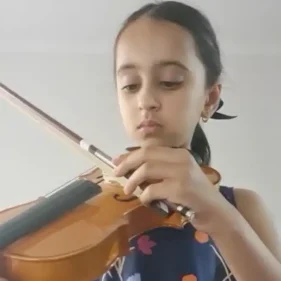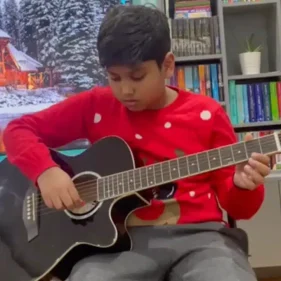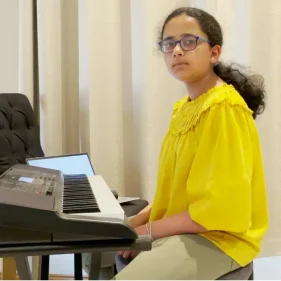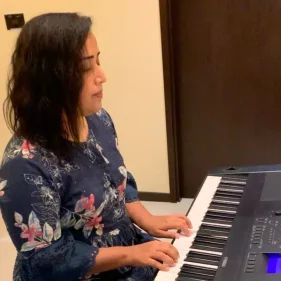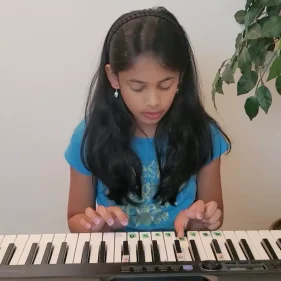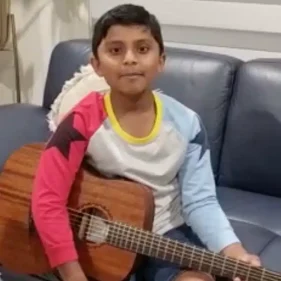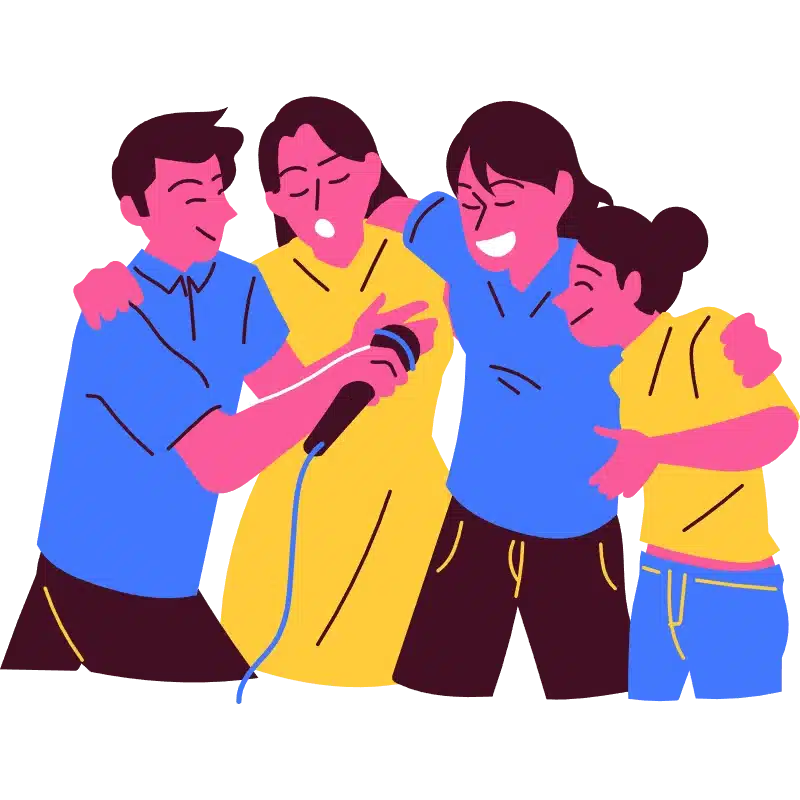- What is the Theory of Bhimpalasi Raag?
- Technical Details of Raag Bhimpalasi
- What is the Speciality of Raag Bhimpalasi?
- Raag Bhimpalasi Aaroh Avroh and Swar Notations
- Raag Bhimpalasi – Bandish for Practise
- Sampakritik Ragas
- Raag Bhimpalasi Information: The Soul Essence of Bhimpalasi Raga
- What is the Mood of Bhimpalasi Raag?
- Popular Bollywood Songs in Raag Bhimpalasi
- More Raag Bhimpalasi Based Songs
- FAQs
Raag Bhimpalasi is usually closely related with Viraha rasa, pain of separation. Raag Bhimpalasi or Bheempalasi is a Hindustani Classical Raga derived from Kafi Thaat. Let’s look into some of Raag Bhimpalasi’ details. Basically, everything you need to know about Raag Bhimpalasi Aaroh Avroh including Bhimpalasi raag’ notes in English for easy understanding.
What is the Theory of Bhimpalasi Raag?
It is one of the most ancient Ragas and was the standard scale before Bilawal. An oft-heard compound Raga churned out of Bhim (vast, big) and Palasi (a tree), this has overshadowed both its Janak (parent) Ragas. Let us get into some Raag bhimpalasi parichay.
Mythically Lord Krishna, the cowherd boy, played this sweet melody on his flute to give a return call to all his grazing cows and cowherd friends. As such this Raga, exuding peace and assurance, is associated with homecoming and offers a vast canvas for improvisations. The universal appeal of this Raga has made it very popular in every genre of Indian music; so much so that Bhim and Palasi are almost extinct now. Raag Bhimpalasi is also adopted by the Carnatic music stream as Bhimpalas or Bheempalas.
Technical Details of Raag Bhimpalasi
Bhimpalasi is a Raga which is very much associated with a hot Indian afternoon. One could say Bhimpalasi Raag time to be afternoon. It is an Audava-Sampoorna jati Raga, implying that it has five notes in Aaroh (ascending) and seven notes in Avroh (descending). The madhyam (fourth) is the most important – an important “nyaas” sthaan (note for rest) with emphasized elaboration around this note – Sa ga ma, ma ga ma, ga ma pa, ma pa ga ma pa (ma) ga (ma) ga ma. The Rishabh (second) and the Dhaivat (sixth) are skipped in Aaroh , but are given due importance in Avroh, hence clarifying the Audava-Sampoorna jati of the Raga.
So now the answer to ‘What are the Raag Bhimpalasi notes?
It has Komal Nishad and Gandhar, Vadi Swar is Madhyam and Samvaadi is Shadaj. Raag bhimpalasi notes in English are Ni Sa Ga Ma, Pa, Ni Sa. Sa’ Ni Dha Pa Ma, Ga Re Sa.
What is the Speciality of Raag Bhimpalasi?
Raag Bhimpalasi notes follow a unique structure, in Avroh, Dhaivat is linked with Pancham (i.e. Pancham is used as a Kan-Swar). Likewise, Rishabh is linked with Shadaj (i.e. Shadaj is used as Kan-Swar). Similarly, while rendering Nishad, adjacent Shadaj is used as a Kan-Swar (in Meend) likewise Gandhar is rendered with Madhyam as a Kan-Swar (in Meend).
Among day-Ragas, Raag Bhimpalasi’s bandish sound is very sweet and hauntingly pleasant. The initial development via Alaap is done very artistically to produce the Raag mood which is then thrown into waves with Taans. The rendering of Komal Nishad needs practice with these combinations: ga ma pa ni sa’ ni sa’ ni sa’ . Rendering this way will give the required higher shruti to Komal Nishad.
Raag Bhimpalasi Aaroh Avroh and Swar Notations
| Swaras | Rishabh and Dhaivat Varjya in Aaroh, Gandhar and Nishad Komal. Rest all Shuddha Swaras. |
| Jati | Audav – Sampurna |
| Thaat | Kafi |
| Vadi / Samvaadi | Madhyam / Shadaj |
| Ideal time to sing | (12 p.m. – 3 p.m.) ; Third Prahar of the day |
| Vishranti Sthan | Sa; Ma; Pa; – Sa’; Pa; Ma; |
| Aaroh | .Ni Sa Ga Ma, Pa, Ni Sa’ |
| Avroh | Sa’ Ni Dha Pa Ma, Ga Re Sa |
| Mukhya – Ang | .Ni Sa Ma, Ma Ga, Pa Ma, Ga, Ma Ga Re Sa |
Raag Bhimpalasi – Bandish for Practise
Refer to the following audio to understand the chalan (aaroh ,avroh, pakad) of the Raga. The audio also includes Sargam Geet (which is sung in Jhaptaal Madhya Laya, starts from Sam) in order to build a strong foundation of the Raga.
Note – A dot before Ni and Ga denote lower octave or mandra saptak.
Ni and Ga denote Komal Nishad and Komal Gandhar.
Bandish 1 : Sargam Geet
Sargam Geet
STHAYI
.Ni Sa Ma Ga Re Sa – .Pa .Ni Sa -2
.Ni Sa Ma Ga Ma Pa Ma Ga Re Sa -2
.Ni Sa Ma Ga Ma Pa Ni Pa Ni Sa’ -2
Ni Dha Pa Ma Ga Pa Ma Ga Re Sa
ANTARA
Ma Pa Ma Ga Ma Pa Ni Sa’ -2
Ni Sa’ Ma’ Ga’ Re’ Sa’ – Ni Dha Pa -2
Pa Re’ Sa’ Sa’ Re’ Ni Sa’ Pa Ni Dha
Pa Ma Ga Ma Pa Ga Ma Ga Re Sa
Bandish 2 : Ja ja re apne mandirwa notation
Ja ja re apne mandirwa one of the most famous compositions sung in Madhya Laya Teentaal (middle tempo 16 beat cycle) starting from Khali, said to be composed by the famous “Sadarang”. This composition Raag Bhimpalasi notes is pretty much a staple of musical schools on this Raga, and conveys an exchange between two people full of tension but love at the same time. Lyrics and Bhimpalasi raag harmonium notes with Raag Bhimpalasi alap and taan, are as follows:
STHAYI
Ja Ja Re Apne Mandirwa -3
Sun Paavegi Mori Saaans Nanadi
Sun Paavegi Saans Nanadiya
ANTARA
Sun Ho Sadarang Tumko Chahat Hai -2
Kya Tum Humko Chagan Diya
TAAN
STHAYI
1. Ga Ma Pa Ma Ga Ma Pa Ma Ga Ma Ga Re Sa – (7 Matra)
2. Ga Ma Pa Ni Sa’ Ni Dha Pa Ma Ga Ma Ga Re Sa (7 Matra)
3. Pa Ni Pa Ni Sa’ Ni Dha Pa Ga Ma Pa Ma Ga Re Sa (8 Matra)
4. .Ni Sa Ga Ga, Sa Ga Ma Ma, Ga Ma Pa Pa, Ma Pa Ni Ni
Pa Ni Sa’ Sa’ Pa Ni Sa’ Ni Dha Pa Ma Ga Re Sa .Ni Sa (16 Matra)
ANTARA
1. Pa Ni Pa Ni Sa’ Ni Dha Pa Ga Ma Pa Ni Pa Ni Sa’ – (8 Matra)
2. Ga Ma Ma Ga Pa Pa Ga Ma Ga Pa Ma Ni Ni Dha Pa Ma
Ga Ma Pa Ni Sa’ Pa Sa’ Ni Ga’ Re’ Sa’ Ni Dha Pa –
Ga Ma Ma Ga Pa Pa Ma Ga Re Sa .Ni Sa – (24 Matra)
3. Sa Ga Ma Sa Ma Ga Re Sa Ga Ma Pa Ga Ni Dha Pa Ma
Pa Ni Sa’ Pa Sa’ Ni Dha Pa Ni Sa’ Ga’ Re’ Sa’ Ni Dha Pa
Ga Ma Pa Ni Dha Pa Ma Pa Sa Ga Ma Pa Ma Ga Re Sa
(Ga Ma Pa Ni Sa’ Ni Dha Pa Ma Ga Re Sa -3) (48 Matra)
Bandish 3 : Mope Rang Na Daro Banwari
This Raag Bhimpalasi Bandish is sung in Teen Taal Drut Laya. Sam arrives at Wari in Sthayi while Antara starts with Khali.
STHAYI
Mope Rang Na Daro Banwari -2
Mori Chunari Bheeg Gayi Aaj Saari -2
ANTARA
Tum Toh Hatheele Nand Laal Chabeele -2
Brindavan Ke Tum Ho Rangeele -2
Baiyan Padat Araj Karat Maano
Maano Maano Girdhari
Bandish 4 : Bhajman Nishadin Shyam
This Bandish is sung in Teen Taal Drut Laya and starts from Khali.
STHAYI
Bhajman Nishadin Shyam Sundar -2
Sukh Sagar Hari Shree Radha Var -2
ANTARA
Sakal Jagat Ke Jeevan Dhan Prabhu -2
Karat Kripa Nit Nij Bhaktan Par
Sampakritik Ragas
Samprakritik – the word itself defines that the Ragas which share similar nature and swaras but different gaayan (styles of playing and singing), chalan (flow), vadi, samvadi, aaroh, avroh, nyasa swara, time are called Samprakritik Ragas.
Kafi Thaat is known to be crowded with numerous similar Ragas, so it is very important to pay attention to their pakads, otherwise one may inadvertently impinge upon them and thus may spoil the performance. Raag Bhimpalasi is a Poorvang Pradhan Raag and is expanded freely in all the three Octaves.
In Hindustani Classical, Raga Dhanashree is much similar to this Raga, the key difference is Dhanashree has Pancham as a Vadi Swar whereas Raag Bhimpalasi notes has Madhyam as a Vadi Swar which implies that Dhanashree is characterized by a dominant Pancham. When the accent is shifted off the Pancham and the Madhyam is advanced, the result is an avirbhava of Raag Bhimpalasi and it is precisely this preponderance of the Madhyam (nyasa bahutva) that bestows on Bhimpalasi its allure. Some of the other similar Ragas in Hindustani Music are Bageshree, Dhani, Patdeep, Hamsakinkini and Patdeepaki.
In Carnatic Music, Karnataka Devagandhari is the most similar Raga, falling with Melakarta 22 (Karaharapriya). One could say that Bhimpalasi Raga in Carnatic is Raga Abheri. It is believed to be a rough equivalent of Hindustani Raga Bhimpalasi. But as with most Ragas, the treatment of the Raga is very different in the systems.
Raag Bhimpalasi Information: The Soul Essence of Bhimpalasi Raga
The ati-madhur and ati-priya Raag Bhimpalasi has the penetrating power to infect the human mind and control it for days and weeks on end. There is as yet no known antidote to the Raag Bhimpalasi contagion. Fortunately, it strikes only those with a mind and so the damage is restricted to a very small fraction of humanity. Suppressed longing of a lover, but serene with dignity and yet throbbing with deep emotion, this Raga depicts Shringar Rasa (poignant and passionate, filled with yearning).
The Raga brings together a joyful mood, with a sweet tinge of resignation but never a mood of hopelessness. The Raag Bhimpalasi time is prescribed is late afternoon, after the sun’s harsh rays start receding in intensity. It has a gentle and sweet feeling of looking forward to the evening ahead.
The name of the Raga is quite overbearing (possibly because of the inclusion of the phrase “Bhim” which stands for big and strong, it was also the name of the strongman Bhim in the epic Mahabharata). However, the Raga is anything but strong and aggressive, it’s soft and sweet and it actually lends itself more to the latter part of its name “Palasi” related to the “Palash” flower perhaps!
What is the Mood of Bhimpalasi Raag?
The Raga also depicts Shanti Rasa (sense of calmness). Some studies say that the Raga has a positive effect on the neurons of the brain as it evokes serenity. The subjects used in the experiment imagined themselves wandering at some beautiful place or the feeling or presence of God or the aura of positivity of the God. People listening to Bhimpalasi feel light, happy, relaxed, refreshed and calm whereas the members of the non-experimental group lived their regular routine life experiencing no such feeling.
Now let’s look into some of Raag Bhimpalasi songs.
Popular Bollywood Songs in Raag Bhimpalasi
Few Ragas lend themselves as easily to an expression of elegance as Bhimpalasi. Some of the most evocative compositions of Shringar Rasa of Hindustani music are in this Raga. This is due to both the progression of the Raga as well as the interpretations of different artists. Based on Bhimpalasi, Kishori Amonkar, heralded an approach which emphasized the emotional and evocative aspect of Hindustani Music, which would often come at the cost of breaking away from certain orthodoxies. Rang So Rang Milaye is an archetype of that approach to music.
Ustad Bismillah Khan’s recital of this Raga on Shehnai can make someone gradually fall in love with this Raga. Get a glance of Ustad Shahid Parvez Khan’s performance from Bazm E Khas.
While Hindustani Classical Ragas follow a set pattern of notes, the film songs based on this Raga may not necessarily follow every rule of this Raga. Composers may take liberty to experiment with the notes and may deviate from the set pattern just to enhance the melody of the song. Here are few popular bollywood Raag Bhimpalasi songs.
1. Naino Me Badra Chhaye sung by Lata Mangeshkar from the movie Mera Saaya.
2. Kismat Se Tum Humko Mile by A.R Rahman.
3. Tum Mile Dil Khile sung by Kumar Sanu and Alka Yagnik.
4. Radha Kaise Na Jale from the famous movie “Lagaan”.
The scale of Bhimpalasi is equivalent to the Western scale is the Blues scale. Many western Pop songs look similar to this Raga. If you listen carefully to the very popular song of Ed Sheeran “Shape Of You”. This song is also influenced by Bhimpalasi.
More Raag Bhimpalasi Based Songs
Radha Kaise Na Jale
Featuring the voice of Asha Bhosle, ‘Radha Kaise Na Jale’ is an one of the Raag Bhimpalasi songs. The soundtrack is best known for its lively rhythm and catchy melody that’s written based on Raag Bhimpalasi characteristics.

Tere Sadke Balam
There is a delicate balance of Hindustani classical elements of Raag Bhimpalasi parichay. It is performed by the legendary singer Lata Mangeshkar. The deep, emotional romantic expression is one of the reasons it won millions of listener’s hearts.

Khilte Hain Gul Yahan
I must say that ‘Khilte Hain Gul Yahan’ invokes Bhimpalasi Raag time. This song is beautifully performed by Kishore kumar. Bhimpalasi is itself known for the emotions such as longing and yearning. This song just as well, brings out the beauty of not just Raag Bhimpalasi aaroh avroh, but also the other patterns of sargams.

Aa Neele Gagan Tale Pyar Hum Karen
Aa Neele Gagan Tale Pyar Hum Karen is yet another fantastic soundtrack that highlights the beauty of Raag Bhimpalasi sargams. Soulfully sung by Hemnath Kumar and Lata Mangehskar. It indeed was a big hit and is still remembered fondly by many.

Beena Madhur Madhur Kachhu Bol
This is a lovely thumri written with Raag Bhimpalasi notes. Saraswathi Rane gracefully sings ‘Beena Madhur Madhur Kachhu Bo’ with just the right Raag Bhimpalasi characteristics.

FAQs
What is the mood of Raag Bhimpalasi?
The mood of Raag Bhimpalasi is calm, devoted and deep emotions.
What are the notes in Raag Bhimpalasi?
The notes in Raag Bhimpalasi are Ni Sa Ga Ma Pa Ni Sa and Sa Ni Dha Pa Ma Ga Re Sa.
What are the health benefits of Raag Bhimpalasi?
The health benefits of raag Bhimpalasi includes relaxation, stress reduction, increased focus and emotional healing.
What is the Carnatic equivalent of Bhimpalasi?
Raag Abher is said to be the Carnatic equivalent of Bhimpalasi
How to play Raag Bhimpalasi on piano/flute/guitar?
Getting started with learning Raag Bhimpalasi information is a good way to play Raag Bhimpalasi on piano/flute/guitar.
What are the key characteristics of Raag Bhimpalasi?
Raag Bhimpalasi characteristics include its afternoon raag usually expressing the emotions of devotion, longing and a sense of melancholy.
How to identify Raag Bhimpalasi in a song?
Finding out the signature patterns such as Ni Sa Ra Ga and Sa Ni Dha Pa.
What are the emotional characteristics of Raag Bhimpalasi?
The emotional characteristics of Raag Bhimpalasi are gentle, soothing, contemplative.
How to sing Raag Bhimpalasi for beginners?
Focusing on emphasizing komal Ni and Ga is one of the way to sing Raag Bhimpalasi for beginners.
Related Blog: Raag Bhairavi




















